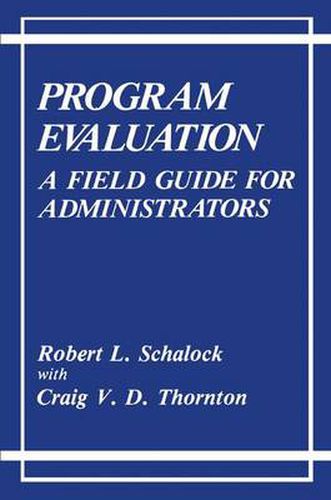Readings Newsletter
Become a Readings Member to make your shopping experience even easier.
Sign in or sign up for free!
You’re not far away from qualifying for FREE standard shipping within Australia
You’ve qualified for FREE standard shipping within Australia
The cart is loading…






This title is printed to order. This book may have been self-published. If so, we cannot guarantee the quality of the content. In the main most books will have gone through the editing process however some may not. We therefore suggest that you be aware of this before ordering this book. If in doubt check either the author or publisher’s details as we are unable to accept any returns unless they are faulty. Please contact us if you have any questions.
This book is written to help human service program administrators either in terpret or conduct program evaluations. Our intended audience includes admin istrators and those students being trained for careers in human services administration. Our focus is on persons interested in assessing programs in which people work with people to improve their condition. The book’s title, Program Evaluation: A Field Guide for Administrators, describes how we hope you use this book-as a tool. In writing the book, we have attempted to meet the needs of persons who have to conduct program evaluations as well as those who must use those evaluations. Hence, we have attempted to make the book user friendly.
You will find, for example, numer ous guidelines, cautions, and specific suggestions. Use the book actively. Our primary motive is to help administrators make better decisions. In fact, the primary reason for program evaluation is to help program administrators make good decisions. These decisions often must balance the goals of equity (or fairness in the distribution of goods and services among people in the economy), efficiency (obtaining the most output for the least resources), and political feasi bility. Take, for example, the administrator who must decide between a new program favored by some of the program’s constituents, and maintaining the status quo, which is favored by other constituents.
$9.00 standard shipping within Australia
FREE standard shipping within Australia for orders over $100.00
Express & International shipping calculated at checkout
This title is printed to order. This book may have been self-published. If so, we cannot guarantee the quality of the content. In the main most books will have gone through the editing process however some may not. We therefore suggest that you be aware of this before ordering this book. If in doubt check either the author or publisher’s details as we are unable to accept any returns unless they are faulty. Please contact us if you have any questions.
This book is written to help human service program administrators either in terpret or conduct program evaluations. Our intended audience includes admin istrators and those students being trained for careers in human services administration. Our focus is on persons interested in assessing programs in which people work with people to improve their condition. The book’s title, Program Evaluation: A Field Guide for Administrators, describes how we hope you use this book-as a tool. In writing the book, we have attempted to meet the needs of persons who have to conduct program evaluations as well as those who must use those evaluations. Hence, we have attempted to make the book user friendly.
You will find, for example, numer ous guidelines, cautions, and specific suggestions. Use the book actively. Our primary motive is to help administrators make better decisions. In fact, the primary reason for program evaluation is to help program administrators make good decisions. These decisions often must balance the goals of equity (or fairness in the distribution of goods and services among people in the economy), efficiency (obtaining the most output for the least resources), and political feasi bility. Take, for example, the administrator who must decide between a new program favored by some of the program’s constituents, and maintaining the status quo, which is favored by other constituents.